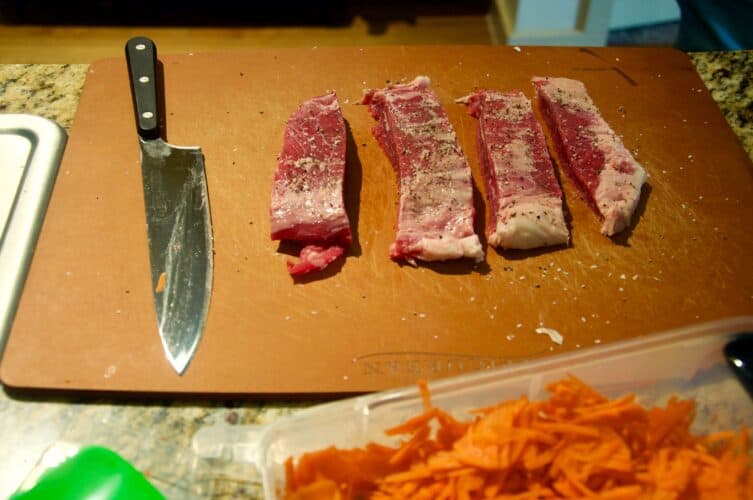This post contains affiliate links. As an Amazon Associate I earn from qualifying purchases
Cutting frozen meat can be a daunting task, even for seasoned cooks. The frozen block of meat can seem impenetrable, but with the right tools and techniques, you can make this challenging job easier. In this guide, I’ll share some expert tips on how to cut frozen meat at home, ensuring you maintain the quality of your meat while keeping your kitchen safe.
Table of Contents
Is Thawing and Refreezing Meat Safe?
Before we dive into the cutting techniques, let’s address the common practice of thawing and refreezing meat. While some may resort to this method, it’s not recommended due to the risks of microbial growth, texture and flavor degradation, and increased chances of freezer burn. To maintain both health and taste, it’s crucial to learn how to cut frozen meat properly.
How To Cut Frozen Meat
Choosing the Right Tools
The first step in cutting frozen meat is to equip yourself with the right tools. Remember that frozen meat is exceptionally solid, so standard kitchen knives won’t suffice. Regardless of your chosen method, first of all, don’t forget cut resistant gloves.
1.Electric Kitchen Table Saw
While an electric meat saw can make cutting frozen meat easy, it is an expensive option primarily suitable for commercial establishments. It requires expertise and safety precautions, including wearing safety glasses, as bones may splinter.
2.Reciprocating Saw
A handheld electric saw is a more affordable alternative to the electric table saw. It’s easily storable, versatile, and allows for quick blade changes. However, it can be a bit awkward to handle when dealing with slippery, frozen meat.
Here is an excellent video demonstrating this tool.
3.Manual Butcher’s Saw
This tool is like a hacksaw with larger teeth. It offers good leverage and is suitable for various thicknesses of frozen meat. Choose one with a comfortable handle for a solid grip, making the task easier and safer.
4.The Butcher’s Knife
A heavy-duty, serrated-edge butcher’s knife can also be used, but it requires substantial effort. To make the process smoother, run the part of the meat you’re cutting under cold running water for a few minutes. Avoid using regular knives, as they won’t handle the task effectively, and can be dangerous to use as they will probably not be as sharp, therefore will easily slide while you are trying to cut.

In some instances, the meat chunks could have bones, and even the strongest of butcher knives will not come in handy. In this case, you need to have a butcher’s saw or a sterilized hacksaw to cut through the bones.
5.Manual Meat Slicer
For thinner meat slices, a manual meat slicer is a useful tool, especially for stir-fries. However, it’s not suitable for cutting thick, frozen roasts.
6.Electric Meat Slicer
An electric meat slicer is an excellent choice for slicing slightly thawed meat, but avoid using it on completely frozen meat to prevent blade damage.
7.Meat Cleaver
For thinner cuts, a solid meat cleaver can do the trick with a simple whack.
The Cutting Process:
Once you’ve chosen the right tool, follow these steps for a successful meat-cutting experience:
- Secure Workspace: Place the frozen meat on a flat, well-grounded cutting board to prevent it from slipping. You can use a towel or paper towel beneath the board for added stability.
- Apply Steady Pressure: Start cutting from the knife’s point, slicing away from yourself while applying steady and controlled pressure to penetrate the frozen meat. Avoid excessive force to reduce the risk of accidents.
- Mind Your Fingers: Always be aware of the position of your fingers, especially if you’re not wearing cut-resistant gloves.
Conclusion:
Cutting frozen meat can be challenging but manageable with the right tools and techniques. Remember that an electric saw or a butcher’s knife is your best bet for tackling this task effectively. Stay safe, keep your tools clean, and enjoy perfectly cut frozen meat for your culinary creations.

